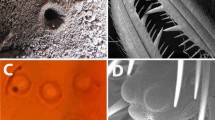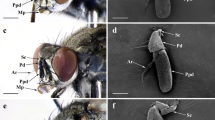Abstract
Electrophysiological recordings were made of chemoreceptors on the tarsi of the first legs of the predatory mitePhytoseiulus persimilis A.-H. The high electrical resistance of the tissue (30–170 GΩ) necessitated electrode insertion very close to chemoreceptor cells to obtain spikes of detectable amplitude. Responses were obtained to two of the four known components of a volatile kairomone that is used in distant prey location. This first electrophysiological investigation of chemoreception in phytoseiid mites proves the chemoreceptive function of the tarsal receptors. However, due to extreme technical difficulties the results were too incomplete to allow comparison with investigations on the behavioral response towards the chemicals tested.
Similar content being viewed by others
References
Dicke, M., van Beek, T.A., Posthumus, M.A., Ben Dom, N., van Bokhoven, H. and de Groot, Æ., 1990a. Isolation and identification of volatile kairomone that affects acarine predatorprey interactions: involvement of host plant in its production. J. Chem. Ecol., 16: 381–396.
Dicke, M., Sabelis, M.W., Takabayashi, J., Bruin, J. and Posthumus, M.A., 1990b. Plant strategies of manipulating predator-prey interactions through allelochemicals: prospects for application in pest control. J. Chem. Ecol., 16: 3091–3118.
Egan, M.E., 1976. The chemosensory bases of host discrimination in a parasitic mite. J. Comp. Physiol., 109: 69–89.
Jackson, G.J., 1974. Chaetotaxy and setal morphology of the palps and first tarsi ofPhytoseiulus persimilis A.-H. (Acarina: Phytoseiidae). Acarologia, 16: 583–594.
Jagers op Akkerhuis, G., Sabelis, M.W. and Tjallingii, W.F., 1985. Chemosensilla on the pedipalps and first tarsi ofPhytoseiulus persimilis A.-H. Ultrastructure and possible function. Exp. Appl. Acarol., 1: 235–251.
Roessingh, P., 1989. Trail marking and following by larvae of the small ermine mothYponomeuta cagnagellus. Ph.D. Thesis, Agricultural University Wageningen, Netherlands, 119 pp.
Sabelis, M.W. and Dicke, M., 1985. Long-range dispersal and searching behaviour. In: W. Helle and M.W. Sabelis (Editors), Spider Mites, Their Biology, Natural Enemies and Control. Elsevier, Amsterdam, B, pp. 141–160.
Author information
Authors and Affiliations
Rights and permissions
About this article
Cite this article
de Bruyne, M., Dicke, M. & Tjallingii, W.F. Receptor cell responses in the anterior tarsi ofPhytoseiulus persimilis to volatile kairomone components. Exp Appl Acarol 13, 53–58 (1991). https://doi.org/10.1007/BF01268939
Accepted:
Issue Date:
DOI: https://doi.org/10.1007/BF01268939




